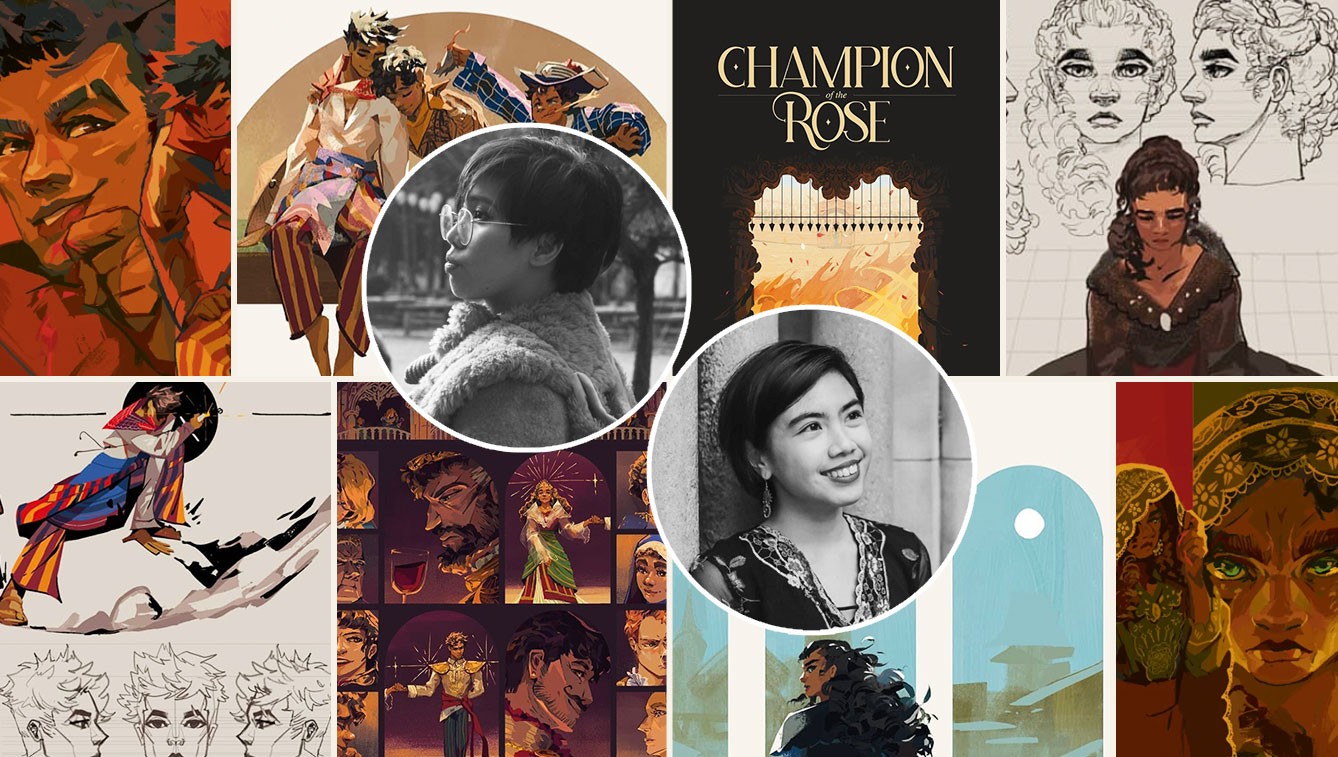MANILA, PHILIPPINES — Champion of the Rose, an upcoming four-volume manga series by Cat Aquino and Dominique Duran, is a queer, anti-colonial high fantasy that delves into a world of blood magic, deadly tournaments, and a Dying God set against the bleak backdrop of a fantasy world inspired by the Spanish colonization of the Philippines.
This anti-imperialist story of trauma, magic, vengeance, solidarity, and revolution comes alive through Rosa, the crown princess of Sagrada who hopes to someday bring justice to all colonized peoples, and Rey, a trans swordsman thousands of miles away from his home who enters a deadly tournament where the winner will be granted Rosa’s hand in marriage. For Rosa, winning her own hand is crucial in her rebellion against the state and her family and in her journey towards dismantling the very powers and privilege she was born into. Because of this, Rey steps up to the lethal task as her champion, all for the promise that he will get his freedom in return.


In March 2023, it was announced in Publisher’s Weekly that this unapologetically queer, anti-imperialist, and anti-colonial story had found a home: one of the biggest English manga publishers in the business, Viz Media.
Giving us an inside scoop on the journey that led them here, the co-creators sat down to chat with adobo Magazine about the inspirations that sparked the beginnings of Champion, the challenges that come with drawing from real cultures and histories, and the dream-team collaboration that made it all possible.
The birth and transformation of Champion
While the news was only made public last year, Cat and Dominique were offered the deal in December 2021. Afterward, it was months of negotiations and acquisitions until the two finally signed the contract in September 2022. When they could finally announce the amazing news, Cat referred to it as “a childhood dream come true.” And the more Cat, an award-winning Filipino author, editor, and academic based in London, talked about it throughout the interview, the more it became clear just how much they meant it. After all, Champion of the Rose itself has been in the making for years — around 12, at that.
“I always tell people it’s like my firstborn baby because I’ve been writing it since I was 13,” said now-25-year-old Cat, “That’s like half my life!”
The final version of Champion that people will read is quite different from the story Cat created in the early 2010s, which many people may remember as the boom of the YA dystopian and fantasy novels in general.

“I tried making a very like standard Western fantasy story because that was the kind of media that I think was available at that time,” they told adobo Magazine, looking back on the first iterations of Champion, which was told through white, cishet characters and didn’t have the queer and Filipino context that enriches the themes that shape the story.
They’re thankful that they didn’t finish that version because it got to grow as Cat grew — especially since that growing up came with opportunities to study and unpack postcolonial theory, how literature is dominated by the West, and the need to make a conscientious push to get stories from the margins out there. “Reading fellow Filipino writers and other writers from the global south encouraged me to start thinking that maybe I can start turning this fantasy concept into something more grounded in what I grew up with.”
What Cat named the final “nail in the coffin” was their visit to Spain as an undergrad. The vacation had them marveling at the beauty of the country’s preserved history, but it also brought upon two insights they were forced to confront.
“I remember thinking two things. Number one, why do I find so much beauty in my colonizer’s country, when I can’t find that sense of awe in mine? [And second,] how come they get to preserve their culture, and we don’t? I don’t know what my country looks like from the 1600’s in a way that isn’t completely divorced from Spain,” Cat shared. “That encouraged me to do my own research. And in that research, I decided to process it through Champion of the Rose, which became — and had to become — a more Philippine-Spanish colonial-history-centered world.”
From pen to panel
Cat’s story and research come to life not just with their words but also with the expressive and visceral art of Manila-based illustrator Dominique Duran. Dominique is no stranger to the Philippine comic scene as the creator of Thicker Than Water and illustrator for comics such as Ethan Chua and Scott Lee Chua’s graphic novel Doorkeeper. It was actually through Doorkeeper that Cat, who is friends with the writers, and Dominique got connected.

The creative spark between the two was there from the start. Back in the height of the pandemic, what was meant to be a two-hour initial call about the project turned into a six-hour discussion about Champion of the Rose — the lore, the inspirations, the design possibilities, everything. From the jump, the two creators knew this project and partnership had to happen.
On what it felt like to join in as a co-creator for a concept that’s been years in the making, Dominique said, “Having to go into it and go through all of this research and all of [Cat’s] passion, I wanted to step up to the plate since it is their dream project. They’ve been working hard to research and write for this. I felt myself wanting to elevate my own art and elevate my work in a way to match that same energy.”
“I also threw myself at the research, which took a while. I’m a slow reader, so it took a while to catch up on all the research,” she said. “But eventually, we both mutually started buying more research books. The research became something that wasn’t just coming from Cat’s side.”
The two emphasize crediting themselves as co-creators rather than just a writer and illustrator. This is because the process goes beyond the simple “write then illustrate” clear-cut steps that others may perceive it to be. There is constant collaboration between the two creators on the story and visuals of Champion of the Rose.





“I have so many ideas that I have gone through Dominique, then Dominique will [also] throw amazing prompts at me, and then I’ll build on that,” Cat described. “It’s very much a back and forth [and] it’s honestly a really, really fun process. That’s part of why I love working with Dominique. We’ve been working on this for years, but it doesn’t really feel tiring because we’re definitely in this together.”
“It’s a conversation between the writing and the art and finding ways to complement each other. Finding ideas that we can both jump from,” added Dominique. “The way I’ve contributed elements to the story is very similar to how Cat has contributed elements to the design. So, now we’ve both had our hands smeared all over each other’s side of the project. It’s been a very engaging and interesting conversation at that.”
A conversation with history, not a replica of it
The two creators’ collaborative relationship is similar to how they treat research and history. Writing a fantasy story that requires tons of world-building and respect for the historical context that shaped it, especially if that context is as horrific as the Philippines’ colonial history, is difficult. It necessitates constantly asking what should be borrowed and what should be invented.
An instance in which Cat and Dominique had to reckon with in this regard is coming up with character designs. One example is the process of designing Teo, Rey’s best friend in the story, whose arc is about holding onto his heritage and achievements as a warrior. Like his fellow warriors from home, Teo’s victories and survival are mapped onto his skin via tattoos.


“We were looking for the tattoo language of coastal indigenous peoples, specifically in the Visayas region, and started struggling with finding the actual information on that area of the Philippines in that timeline. We went through several phases [of asking ourselves,], ‘So, should we do more research? Is there is there a way of finding this kind of information?’” Dominique recalled. “We found the information in the Boxer Codex, but that doesn’t necessarily tell us what the language of the tattoos means. If I were to [stick to what we found in the Boxer Codex,] there’s this question of whether that’s even respectful because, ultimately, that would just be using the aesthetics rather than having its own tattoo language. It’ll be gibberish then.”
“We found that possibly the way we can do this most genuinely and most respectfully was to make our own language specifically for the tattoos of that culture,” she continued. “It can’t be gibberish. It has to actually tell the story. It has to have a specific symbol and order.”
These instances showed the co-creators the blurry line between solely depending on research and committing cultural appropriation when creating a fantasy work. For Cat and Dominique, the research is not treated as a bible to strictly follow during the process. Rather, they treat it as inspiration or a jumping-off point that helps them expand their world.
“I think the best rule that comes with drawing from historical sources in fiction is to use what you think serves this story ultimately and then add what you think will also add thematically to the story,” Cat said. “Ultimately, I’m always trying to serve what the story is trying to say, and then the history will kind of just be the underlying foundation of that.”
Bringing Champion to readers
All the thought and heart that Cat and Dominique poured into Champion pays off with this publishing deal — one that brings it to a global audience. However, while signing with an international publisher and the big reach it comes with is a huge deal, Cat admitted that a significant factor in trying to sign with a global publisher had to do with practicality.





“We hoped it would have a global audience because we wanted a global publisher. We knew that that would be more sustainable in the long run,” they said. “Unfortunately, US and UK publishers tend to pay higher than Philippine publishers, and it would be difficult to make a 200-to-300-page, four-book graphic novel full-time [without that kind of offer.]”
“If our local publishers at home put more support and investment in the arts and made it more sustainable, then we would have definitely gone with a Philippine publisher.”
Regardless of the global release, it’s no surprise that Cat and Dominique’s priority for readership is to get the attention and hearts of Filipinos. Even before the publishing news, they had already accomplished that on a smaller scale.
When readers got a glimpse of Champion of the Rose through a preview of Cat and Dominique published on Penlab, an online platform for Pinoy comics, the comic quickly blew up. Views racked up, people started talking about the story, and Champion got featured by numerous publications — all from the eight-page sneak peek.
“We’re super grateful to Penlab and everyone who stumbled upon the eight pages online,” Cat said. “Having that constant support over a couple of years helped show publishers that people were interested in us.”
“It created a huge splash in the local comic scene, and that was a huge surprise for us because it was only a handful of pages,” Dominique added. “I’m glad that it caught everyone’s eyes so much. We attracted a lot of the attention that we honestly wanted for the project from the start — attention from our fellow Pinoys. We want them to be able to experience the story specifically.”
If eight pages were enough to rally support and get attention from Filipinos, it’s a safe guess that when the completed work hits the shelves next year, readers within their target audience and beyond will love it.



After all, it’s not every day that unflinchingly anti-colonial stories made by and for people from the global south get a platform like this, and the craft, passion, and care that Cat and Dominique have put into Champion of the Rose show how aware they are of this. From what they’ve shown us so far, this opportunity to build an immersive and inventive fantasy world without shying away from the historical context shaped by the shadows of the Philippines’ colonial past won’t go to waste.
In a world hungry for more diverse stories — specifically ones confronting the history that caused that lack of diverse representation in the first place — Champion of the Rose’s release definitely seems like something you should be looking out for.
The first volume of the Champion of the Rose will have its release date soon. Check out the eight-page preview and check out its official Facebook page to learn more.








